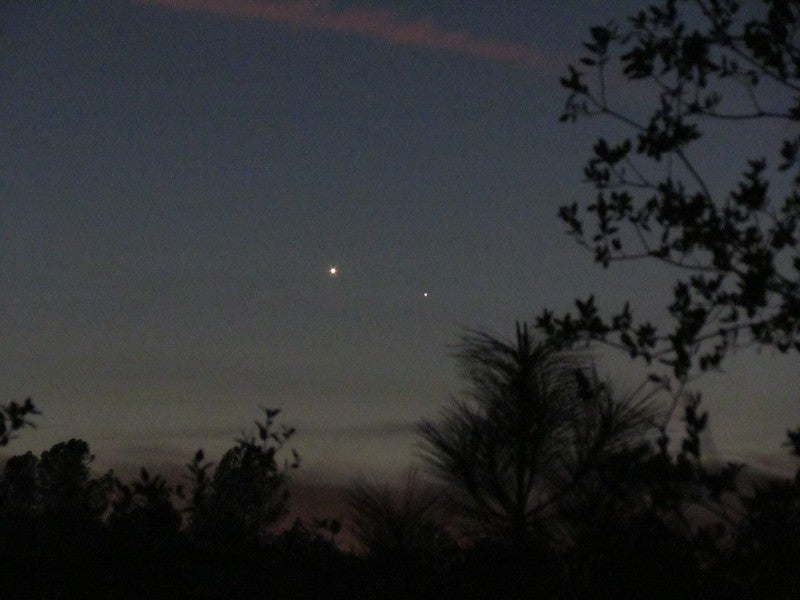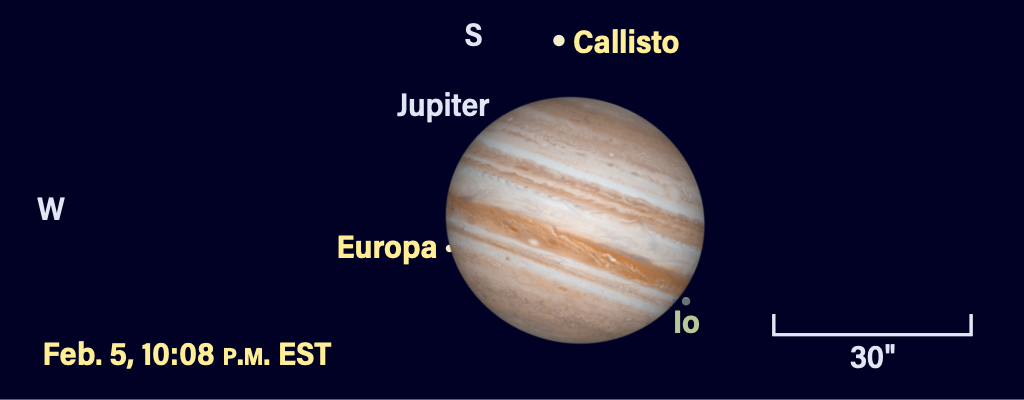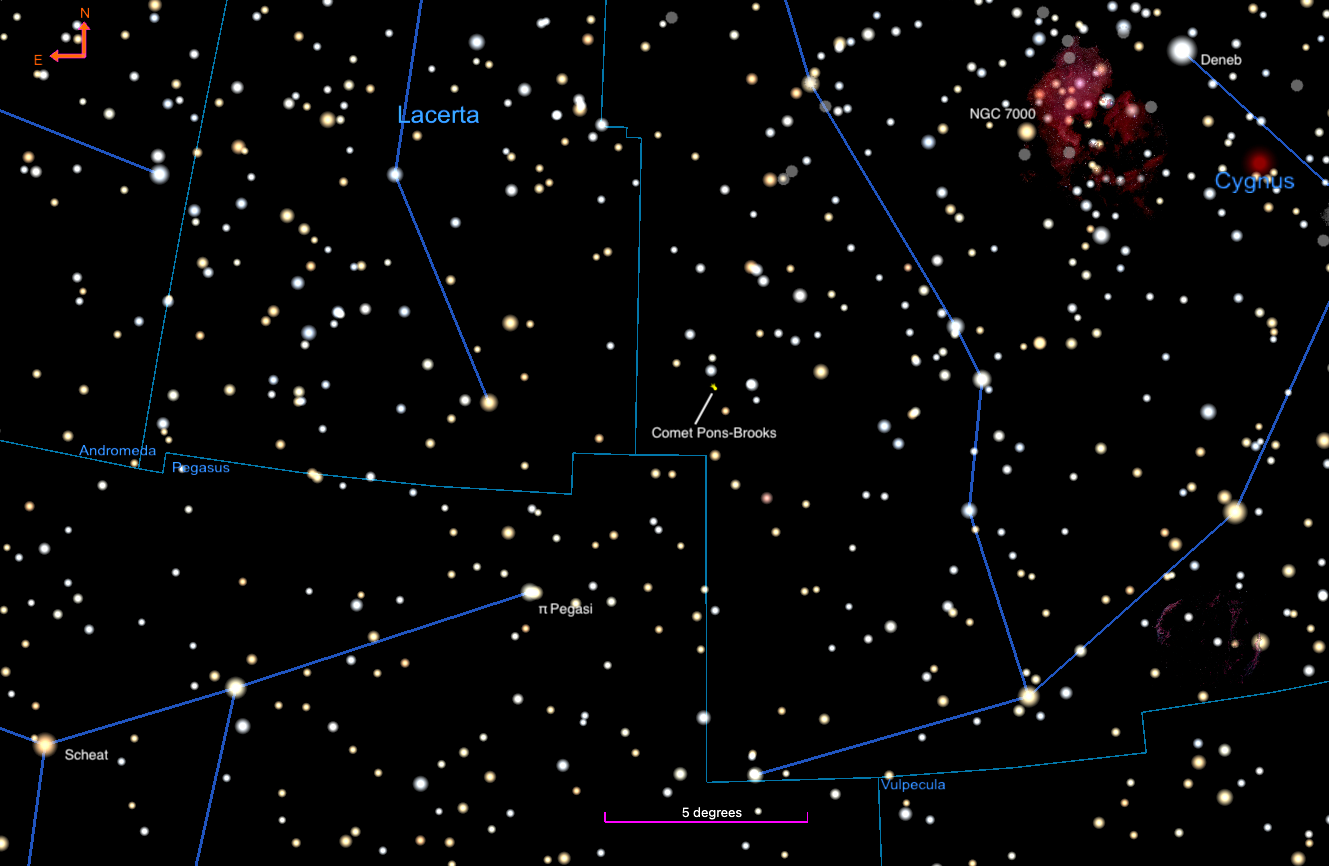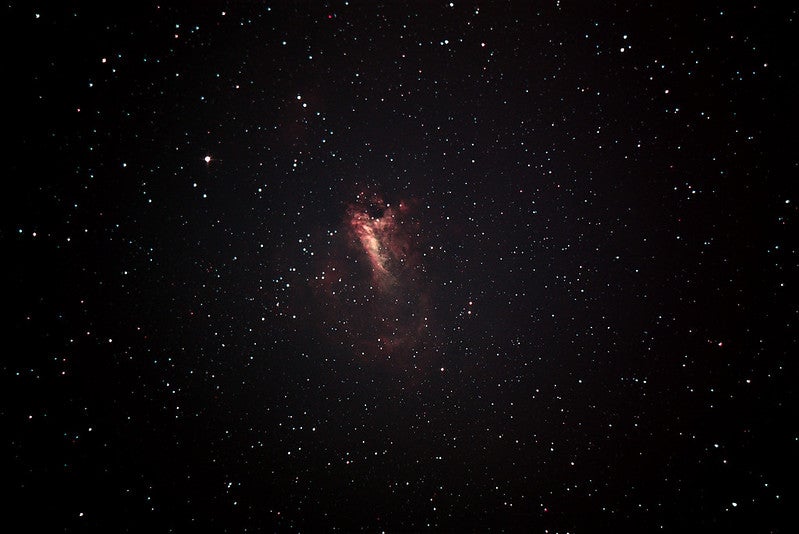
Friday, February 2
Last Quarter Moon occurs tonight at 6:18 P.M. EST.
The constellation Auriga the Charioteer sits just above Gemini the Twins in the east this evening. It’s already quite high an hour after sunset. This constellation is home to three well-known Messier clusters, but tonight we’re going to a lesser-known gem: the open cluster NGC 1893. This young group of stars sits within a larger nebula cataloged as IC 410 (sometimes called the Tadpole Nebula or the Tadpoles). And whether you’re a visual observer or an astrophotographer, it’s worth taking a look.
NGC 1893 shines at collective magnitude of 7.5, making its stars an easy catch for binoculars or any telescope. It lies about 5° north of Elnath in Taurus, the closest bright star. It’s also a 5.4° hop east of Iota (ι) Aurigae, if you prefer a signpost in the same constellation.
This young open cluster is about 11′ wide and appears surrounded by a faint haze — though you’ll need a large scope (12 inches or so) to detect this glow by eye, which is IC 410. Alternatively, photographing the region should really help to bring out IC 410’s glow, even if you can’t see it at the eyepiece. The “tadpoles” for which the nebula is named are two distinct streamerlike “tails” of gas silhouetted against a darker backdrop of dust in the northeastern regions of the complex.
Sunrise: 7:08 A.M.
Sunset: 5:20 P.M.
Moonrise: 12:11 A.M.
Moonset: 10:40 A.M.
Moon Phase: Waning gibbous (52%)
*Times for sunrise, sunset, moonrise, and moonset are given in local time from 40° N 90° W. The Moon’s illumination is given at 12 P.M. local time from the same location.
Saturday, February 3
This morning might hold your last view of the planet Mercury until next month, when it will reappear in the evening sky. Headed for superior conjunction in late February, Mercury lies close to the horizon this morning as dawn approaches.
You’ll find the small planet just 2° high in the southeast some 30 minutes before sunrise. Although it’s low, it’s also bright, shining at magnitude –0.4. Only Venus is noticeably brighter, 10° high and about 14° to Mercury’s west (upper right). Mars is sandwiched between the two planets, slightly closer to Mercury. The Red Planet is a faint magnitude 1.3 and 5° high at this time.
Compare the three planets through a telescope. Venus is 86 percent lit and the largest at 12″ across. Mars appears full and stretches just 4″ in diameter. Mercury, if you can catch it, is slightly larger than Mars — 5″ across — and slightly more illuminated than Venus at 90 percent lit.
Mercury will continue to sink lower at the same time each day, rendering it harder to see as it descends into morning twilight.
Sunrise: 7:07 A.M.
Sunset: 5:21 P.M.
Moonrise: 1:16 A.M.
Moonset: 11:08 A.M.
Moon Phase: Waning crescent (42%)
Sunday, February 4
The Moon passes 0.6° north of Antares at 8 P.M. EST. This bright red star marks the heart of Scorpius the Scorpion and sits in a rich region near the plane of our Milky Way Galaxy.
Because the region is not visible in the evening sky, you’ll have to catch it in the early morning instead. Two hours before sunrise, look south to find the crescent Moon sitting between 2nd-magnitude Delta (δ) Scorpii and 3rd-magnitude Pi (π) Scorpii. About 7° to the lower left (east) of the Moon is Antares, a magnitude 1.1 red giant.
Antares’ red color is generally noticeable even with the naked eye. Its name translates to “rival of Mars,” so given because it can be easily mistaken for Mars in the sky, thanks to its color and brightness.
Look about 3° above (north-northwest of) Antares and you’ll land on the magnitude 4.6 star Rho (ρ) Ophiuchi. This star lies in the midst of a huge complex of stars, nebulae, and molecular clouds, and is one of the most colorful regions of the sky for astrophotographers to photograph. (Note, however, that the eye will only see the nebulae as gray or white through a telescope.) Rho itself is a binary with two hot, blue components separated by about 3″. The pair is surrounded by a bright reflection nebula, a cloud of dust that reflects (hence the name) the stars’ light.
Sunrise: 7:06 A.M.
Sunset: 5:23 P.M.
Moonrise: 2:24 A.M.
Moonset: 11:43 A.M.
Moon Phase: Waning crescent (32%)

Monday, February 5
Three of Jupiter’s four Galilean moons are putting on a show tonight. You’ll find the giant planet high in the southwest an hour after sunset. Observers in the eastern half of the U.S. will catch all four moons around 7:30 P.M. EST: Ganymede lies far to the west, while Io (closest) and Europa also sit west of the gas giant. Callisto is alone, just southeast of Jupiter.
Twenty-five minutes later, Io has moved in and disappears behind Jupiter’s western limb in an occultation. Callisto is slowly sliding south of the planet — it will sit directly below the south pole around 9 P.M. EST.
Keep watching, because around 10 P.M. EST, two events occur in quick succession. Around 10:05 P.M. EST, Io reappears from behind Jupiter’s eastern limb, but it is dimmed by the planet’s deep, dark shadow. It may be difficult or even impossible to see, so don’t worry if you can’t. Less than five minutes later, Europa — which has also been approaching the western limb — disappears in its own occultation. Callisto by now sits southwest of the planet, having passed beneath the south pole without crossing in front of or behind Jupiter, thanks to the tilt of the moon’s orbit relative to Earth.
Stick with Jupiter another hour or so. Io fully reappears shortly after 11:20 P.M. EST, illustrating just how far Jupiter’s shadow stretches behind it (and clearly showing the location of the Sun relative to the planet). Europa won’t make it out of the shadow until Jupiter has set for all observers in the continental U.S.
Sunrise: 7:05 A.M.
Sunset: 5:24 P.M.
Moonrise: 3:33 A.M.
Moonset: 12:28 P.M.
Moon Phase: Waning crescent (23%)

Tuesday, February 6
Comet 12P/Pons-Brooks is now roughly 8th magnitude, traveling through far eastern Cygnus near the northwestern corner of Pegasus. This region is relatively low in the west an hour after sunset, but you’ll still have time to take a peek under dark skies. For the best prospects, get to an observing site with a little altitude over its surroundings and ensure your western horizon is clear of trees or buildings.
The comet now lies in a region between the bright star Deneb in Cygnus and the Great Square of Pegasus. It is a little less than halfway along a line drawn between magnitude 1.3 Deneb and magnitude 2.4 Scheat, the northwesternmost star in the Square. Once you’re in the region, you can use magnitude 4.3 Pi Pegasi as a closer guide — Pons-Brooks is some 6.7° northwest of this star, near a set of two 6th-magnitude stars. Check out the chart above for more details on its position tonight. It should be readily visible in a telescope, and larger binoculars will also pick up its fuzzy coma.
Just 11° northwest of the comet is the stunning North America Nebula (NGC 7000) if you’ve got time to stop by.
Sunrise: 7:04 A.M.
Sunset: 5:25 P.M.
Moonrise: 4:40 A.M.
Moonset: 1:25 P.M.
Moon Phase: Waning crescent (14%)
Wednesday, February 7
The Moon passes 5° south of Venus at 2 P.M. EST. You can catch this pairing in the early-morning sky about 45 minutes before sunrise, when the two are rising in the southeast as the sky starts to lighten with the dawn.
The Moon is now just 8 percent lit, illuminated only along its western limb. But it’s likely that some earthshine — sunlight reflecting off Earth — may reveal detail even on the darkened regions of the lunar face. Our satellite sits inside the handle of Sagittarius’ Teapot asterism, though the dimmer stars of this constellation are fading quickly in the growing light.
To the Moon’s upper left is bright Venus. Earth’s sister planet is magnitude –3.9 — the brightest object in the predawn sky. Through a telescope, Venus appears 87 percent lit and its disk is 12″ wide.
Mars lies some 7° east of Venus on the ecliptic, to the bright planet’s lower left. It rises an hour before the Sun and shines at magnitude 1.3. You may be able to catch it in binoculars or a telescope as it starts to climb higher, but the sky will also be brightening, hindering your efforts. Make sure to put away any optics at least several minutes before sunrise from your location, which may differ slightly from the time given below.
Sunrise: 7:03 A.M.
Sunset: 5:26 P.M.
Moonrise: 5:40 A.M.
Moonset: 2:34 P.M.
Moon Phase: Waning crescent (7%)
Thursday, February 8
Moving along the ecliptic, the Moon now passes 4° south of Mars at 2 A.M. EST. Our satellite is difficult to catch this morning, rising half an hour before the Sun but only 3 percent lit. If you’re up for the challenge, you can try spotting it and Mars again this morning. The Red Planet rises an hour before the Sun and remains magnitude 1.3.
Evening observers will have a much easier time of things: Asteroid 4 Vesta is stationary at 1 P.M. EST and visible in Taurus this evening. It’s already 60° high in the southeast an hour after sunset, located some 3.7° northwest of magnitude 3 Alheka, the tip of Taurus’ easternmost (and lowest as the constellation rises) horn. Vesta is magnitude 7.4, easily picked up by binoculars or any small telescope. After tonight, it will begin moving eastward relative to the background stars. It covers less than 2° of sky by the end of the month, so you can pick it up in this same spot for the next few weeks.
As a bonus, the famous Crab Nebula (M1) lies less than 3° east-southeast of Vesta and should be readily visible through a good scope from a dark location, particularly with no moonlight to interfere tonight. This tangle of gas and dust is the remnant of a star that went supernova; the light from that explosion was seen in 1054. The Crab itself is about a magnitude fainter than Vesta (magnitude 8.4) and stretches 6′ across at its widest. With the dark skies tonight, try it in binoculars; if you have trouble picking it up, switch to a telescope. The nebula will look like a whitish-gray patch of fuzz.
Sunrise: 7:02 A.M.
Sunset: 5:27 P.M.
Moonrise: 6:31 A.M.
Moonset: 3:53 P.M.
Moon Phase: Waning crescent (2%)

Friday, February 9
New Moon occurs at 5:59 P.M. EST, leaving utterly dark skies to delight deep-sky observers.
Today’s target is for early rises, particularly those with a clear southern horizon. We’re looking for M17, also known as the Omega or Swan nebula. The best time to find it is around 5:30 A.M. local time, when it’s reached 15° altitude in the southeast. It lies above the top of the Sagittarius Teapot asterism, which is just peeking out from the horizon at this time.
Visible with binoculars — though you’ll want as large a telescope as possible to pull out the most detail — M17 sits 9.4° north-northwest of 3rd-magnitude Lambda (λ) Sagittarii and 2.6° southwest of 5th-magnitude Gamma (γ) Scuti. It glows at magnitude 6 and stretches about 11′ at its longest.
Observers report differing shapes depending on the size of their instrument. Smaller scopes show the nebula as a number 2 or, as one of its names suggests, a swan with its delicate neck curved as it glides along the water. Only larger scopes (8 to 10 inches or more) will show that the curve continues, revealing the shape of the Greek letter Omega (Ω). Astronomy contributor Phil Harrington suggests using a narrowband light-pollution or oxygen-III (OIII) filter to bring out more detail and texture in the gas.
Sunrise: 7:01 A.M.
Sunset: 5:29 P.M.
Moonrise: 7:12 A.M.
Moonset: 5:14 P.M.
Moon Phase: New

Sky This Week is brought to you in part by Celestron.









